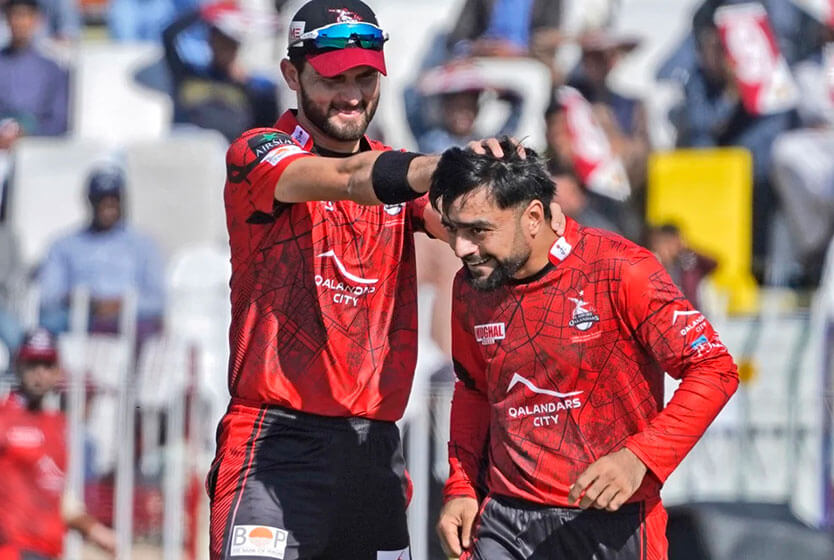
A Cursory Look at PSL’s “New” Emerging Bowlers
Before the resumption of PSL 6, we take a look at how the new pacers in the PSL have fared so far.
Since its inception in 2016, the PSL has produced several players who have gone on to represent Pakistan at the highest level. A fair few of these have been individuals who got their first big shot in the PSL as emerging players. The emerging player category has forced team managements to be forward-thinking and always on the lookout for “the next big thing.” It has been of particular help in Pakistan cricket, where sometimes too much importance is given to “experience” even if it may be experience of failures.
But for every Hasan Ali or Shaheen Shah Afridi, there may be a Ghulam Mudassar or Mohammad Irfan jr. Bowling plans and the correct utilization of players go a long way in determining whether he succeeds at the highest domestic level in Pakistan cricket.
Utilization
Most PSL teams have a settled pace attack, so they opt for an emerging fast bowler most of the time. They then make the more experienced bowlers bowl the tough overs and use the young uns to fill in the blanks.
A look at the over by over run rates of this PSL gives a clear indication of which overs can be regarded as the “easy ones” – the first three overs of the innings where the batsmen are looking to settle and overs 7, 8, & 9 where the batsmen look to consolidate after taking advantage of the Powerplay.
It is here where teams give the ball to their emerging players to fulfill their quota. This way, they get through at least three overs. For the player’s final over, they give him a taste of the death but rarely depend on him to close out games.
Hasnain and Shaheen are now leaders of their respective team’s attacks as classic top-tail bowlers who usually bowl two at the start and two at the death. However, in their first-ever PSL seasons, a majority of their overs were bowled in the middle. That pattern of utilization of emerging players has persisted this season, too, with one notable exception – Shahnawaz Dahani.
| Phases | M Imran | A Daniyal | M Wasim | SSA 2018 | MH 2019 | S Dahani |
| Powerplay | 42% | 27% | 43% | 21% | 36% | 47% |
| Middle | 37% | 60% | 36% | 42% | 39% | 20% |
| Death | 21% | 13% | 21% | 37% | 25% | 33% |
Shahnawaz Dahani – 9 wickets @ 17.22, Econ. 10.33
Dahani has been thrown in and expected to be his team’s lead bowler in his first-ever PSL season. He doesn’t have the luxury to bowl the “easy overs” because his team doesn’t have anybody to bowl the hard ones.
He has responded admirably to be shoved into the deep end of the pool with his natural talent to generate pace and bounce, allowing him to float until he comes to grips with how to bowl in T20s. Batsmen are in control for only 62% of his deliveries, with 38% producing false shots. He does need to quickly learn that bowling length at the death may not be the best idea, with those balls traveling at an economy rate of 15.
| Emerging Bowler | Batsman Control Percentage |
| Shahnawaz Dahani | 62% |
| Ahmed Daniyal | 70% |
| Mohammad Wasim | 71% |
| Mohammad Imran | 76% |
Meanwhile, he does produce a mean yorker, which is very difficult to score off – economy 3.33 with two wickets at an average of 2.5. It is perhaps the balls he bowls at hard or bouncer length that may be the most lethal – he has picked up five wickets with them at an average of 14.60.
Dahani already seems to be at home in the Powerplay, where he is left to his devices with a hard new ball that bends to his will. If he manages to reduce the length balls from his death bowling, he could be the first-ever emerging bowler to be a successful full-fledged top-tail bowler in his debut season.
Ahmed Daniyal – 2 wickets @ 55.50, Econ. 8.73
Daniyal’s utilization is perhaps the antithesis of Dahani’s. He finds himself in a team that contains perhaps the best Powerplay bowler and the best death bowler in Pakistan; all he has to do is fill in the blanks. Looking at his phase-wise break-up, one would think his best phase is the Powerplay, but his future may lie as a third seamer like fellow “tapiya” Haris Rauf.
| Phase | Utilization | Average | Economy |
| Powerplay | 27% | 27.0 | 6.75 |
| Middle | 60% | N/A | 9.22 |
| Death | 13% | 21.0 | 10.5 |
His bowling plans are very similar to that of Haris, naturally emerging from a system that is brutal on any form of length bowling. The bowling policy seems to be either bowl at the head or the toes, with a whopping 83% of his deliveries either attempting for the blockhole or being back of a length. His true value will be seen as Haris’ was when he is allowed an extended run of death bowling. However, that seems unlikely to happen with Shaheen and Haris both dependable death bowlers.
Nevertheless, very few teams will scoff at a third seamer with the ability to bowl at speeds north of 140 kph and a bouncer that had even the great Chris Gayle hopping. Ultimately, our lasting memory of Daniyal thus far will remain the yorker he produced to Colin Ingram, castling him first ball.
Mohammad Imran – 3 wickets @ 44.67, Econ. 7.05
Imran’s approach to the crease and load up is very similar to Daniyal’s, but he is another from Pakistan’s factory of left armers. His angle across from the batsman allows a ball that pitches on middle to end up around off stump. Early on in the Powerplay, he gets a bit of movement that takes the ball even further away, ala a young Usman Shinwari.
Nearly 50% of his balls end up in the channel of uncertainty around the 4th or 5th stump. It is the perfect template for any young left armer in the Powerplay. Predictably, it has brought him great success, registering the third-best economy rate in the Powerplay for PSL 6.
| Bowler | PP Econ | PP Wickets | PP Average |
| Faheem Ashraf | 4.75 | 3 | 12.67 |
| Hasan Ali | 5.00 | 3 | 15.00 |
| Mohammad Imran | 5.38 | 2 | 21.50 |
| Mohammad Wasim | 6.00 | 1 | 36.00 |
| Mohammad Amir | 6.30 | 2 | 30.00 |
Unfortunately, he has thus far been unsuccessful in bringing the ball back into the right-hander, which means that at times he gets predictable just taking the ball away. It is here where he has developed a coping mechanism – slower balls.
While Imran’s slower balls are well disguised, he bowls them too often and becomes predictable once again. They have traveled at an economy of over 9 with an average of over 50; those numbers certainly don’t bode well for a delivery he bowls nearly one-third of the time.
A case study of this affliction is the game against Multan, where he returned in the 12th over to bowl his third over and delivered a wide slower ball first ball. The batsman – Mohammad Rizwan, was surprised by the change of pace and miscued to point, handing Imran the wicket. The keyword being “surprised.” Imran proceeded to bowl 6 to 7 slower balls in his next 11 deliveries.
Imran is an excellent prospect who has control over his line and length at a young age. If he could be guided better to use his other deliveries more liberally, such as his yorker and bouncer, it may fast track his development.
| Ball | Current Utilization | Average | Economy | Control % |
| Slower Ball | 32% | 54.0 | 9.0 | 81% |
| Bouncer | 15% | 28.0 | 9.3 | 44% |
| Yorker | 21% | N/A | 7.0 | 95% |
Mohammad Wasim – 4 wickets @ 26.25, Econ. 7.50
Wasim, on the other hand, has his bowling plans down to a tee. Due to this, he has delivered impressive numbers in both the Powerplay and the death, albeit thanks to being heavily supported by the likes of Hasan Ali and Faheem Ashraf.
| Phase | Overs Bowled | Average | Economy |
| Powerplay | 43% | 36.0 | 6.00 |
| Middle | 36% | 50.0 | 10.0 |
| Death | 21% | 9.50 | 6.33 |
The aforementioned plans are simple and ones any bowling coach would try to instill in his youngsters. In the Powerplay with the new ball, bowl length and look for any movement on offer. Then, at the death, get it in the blockhole. Nearly 80% of Wasim’s deliveries in the Powerplay are delivered on a length, but he switches to 80% at the toes when the death comes around. He has found seam while bowling with the new nut, as shown in his impressive opening burst vs. Zalmi. But perhaps what will excite Pakistan fans the most is how much his slingy-ish action is conducive to reverse swing with his dipping yorker to Rizwan now lasered in everyone’s minds.
Wasim does seem to struggle a bit in the middle overs, where he seems unclear on what he should bowl with movement off the pitch no longer available and batsmen happy to nurdle him around. But even without the tactical nous thus far to succeed in the middle, his current bowling skillset and batting potential make him enticing enough for teams to consider playing him even if he wasn’t an emerging player.
Conclusion
None of these guys are finished products, and most have been utilized by their teams as such. They will need slight technical tweaks and mindset changes before they are ready to play T20 cricket at the highest level (even if that doesn’t really matter because Pakistanis aren’t allowed there anyway). But Pakistan’s pace factory has once again produced an excellent batch of youngsters which we will hope are better utilized than the ones before and the ones before that and the ones before that… Well, you see how it is.







Leave a Reply